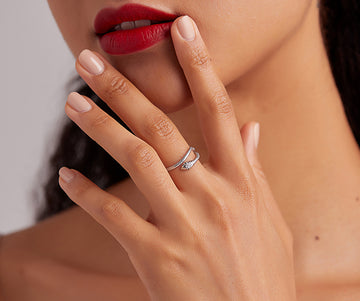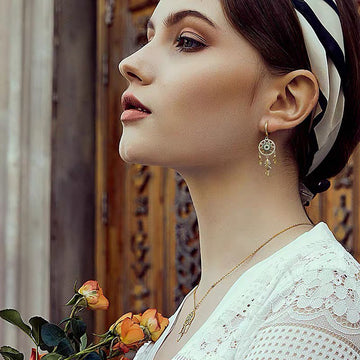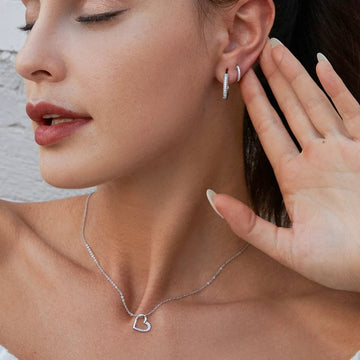Fashion
How Rings Are Made

Rings aren't just accessories—they're miniature works of art, meticulously crafted from metals and stones to capture beauty and emotion in tangible form. Delving into the intricate world of ring design reveals a symphony of elements that blend together to create a masterpiece. Understanding these components not only enriches your appreciation but also empowers you to choose a ring that resonates with quality and style. Let's embark on a journey through the four fundamental elements that shape every exquisite ring:
1. The Head or Setting: Where Magic Meets Stone
At the heart of every ring lies its setting, a stage where the stone takes center stage. Each setting style offers a unique aesthetic and practical considerations:
PRONG: Like delicate fingers cradling a gem, prong settings elevate stones above the band, maximizing light exposure for dazzling brilliance. Perfect for engagement rings, they exude timeless elegance and require occasional maintenance to ensure the stones remain secure.
BEZEL: A metal collar embraces the stone, offering unparalleled security and a sleek, modern look. While bezels reduce light penetration compared to prongs, they enhance durability and are ideal for active lifestyles.
TENSION: Modern and minimalist, tension settings use the band's metal to suspend the stone, creating an illusion of floating gems. They require precise craftsmanship and are tailored to specific stones, ensuring a snug fit but limiting resizing options.
PAVÉ: French for "paved," pavé settings shimmer with clusters of tiny gemstones nestled closely together. Whether adorning a single band or encircling a central stone, pavé settings add opulence and a touch of vintage charm.
2. The Shank or Band: Embracing Elegance
The shank forms the ring's foundation, encircling the finger with grace and style. From classic to contemporary, shank designs cater to every taste and practical need:
TRADITIONAL: A consistent width from front to back, offering timeless simplicity and comfort.
CATHEDRAL: Arches rise from the band to cradle the stone, adding architectural elegance and visual intrigue.
SPLIT: A daring departure, where the shank divides to embrace the stone, creating a dynamic, two-band effect.
MICRO-PAVÉ: Tiny diamonds pave the shank, imparting a subtle sparkle that complements any central stone. Beware, though—it limits resizing options if fully encircled.
3. The Claw: Nature's Embrace
Often referred to as prongs, claws are the unsung heroes of ring design, securing stones with precision and artistry:
V-SHAPED: Offering a secure grip while minimizing visibility, ideal for showcasing larger stones.
HEART-SHAPED: Delicately shaped into symbols of love, adding a romantic touch to any setting.
DECORATIVE: From ovals to points, claws can be sculpted into various shapes, blending functionality with aesthetic appeal.
4. The Shoulder: Where Style Meets Symmetry
The shoulder of a ring extends from the shank to the setting, adding structural support and stylistic flair:
FLARED: Curves and grooves dance along the metal, creating a mesmerizing visual effect that catches the eye.
BYPASS: A whimsical design where the shank curves around the stone like clasped hands, symbolizing unity and strength.
FREEFORM: Embracing artistic freedom, this style bends and twists with the designer's imagination, offering limitless possibilities.
Each element in a ring—whether head, shank, claw, or shoulder—contributes to its character and allure, transforming precious metals and stones into cherished treasures. Whether you're drawn to the classic elegance of a prong-set diamond or captivated by the modern allure of a tension-set sapphire, understanding these elements empowers you to choose a ring that not only dazzles the eye but also resonates with your soul. So, the next time you admire a ring, remember—it's not just a piece of jewelry; it's a testament to craftsmanship, creativity, and the enduring beauty of human expression.
1. The Head or Setting: Where Magic Meets Stone
At the heart of every ring lies its setting, a stage where the stone takes center stage. Each setting style offers a unique aesthetic and practical considerations:
PRONG: Like delicate fingers cradling a gem, prong settings elevate stones above the band, maximizing light exposure for dazzling brilliance. Perfect for engagement rings, they exude timeless elegance and require occasional maintenance to ensure the stones remain secure.
BEZEL: A metal collar embraces the stone, offering unparalleled security and a sleek, modern look. While bezels reduce light penetration compared to prongs, they enhance durability and are ideal for active lifestyles.
TENSION: Modern and minimalist, tension settings use the band's metal to suspend the stone, creating an illusion of floating gems. They require precise craftsmanship and are tailored to specific stones, ensuring a snug fit but limiting resizing options.
PAVÉ: French for "paved," pavé settings shimmer with clusters of tiny gemstones nestled closely together. Whether adorning a single band or encircling a central stone, pavé settings add opulence and a touch of vintage charm.
2. The Shank or Band: Embracing Elegance
The shank forms the ring's foundation, encircling the finger with grace and style. From classic to contemporary, shank designs cater to every taste and practical need:
TRADITIONAL: A consistent width from front to back, offering timeless simplicity and comfort.
CATHEDRAL: Arches rise from the band to cradle the stone, adding architectural elegance and visual intrigue.
SPLIT: A daring departure, where the shank divides to embrace the stone, creating a dynamic, two-band effect.
MICRO-PAVÉ: Tiny diamonds pave the shank, imparting a subtle sparkle that complements any central stone. Beware, though—it limits resizing options if fully encircled.
3. The Claw: Nature's Embrace
Often referred to as prongs, claws are the unsung heroes of ring design, securing stones with precision and artistry:
V-SHAPED: Offering a secure grip while minimizing visibility, ideal for showcasing larger stones.
HEART-SHAPED: Delicately shaped into symbols of love, adding a romantic touch to any setting.
DECORATIVE: From ovals to points, claws can be sculpted into various shapes, blending functionality with aesthetic appeal.
4. The Shoulder: Where Style Meets Symmetry
The shoulder of a ring extends from the shank to the setting, adding structural support and stylistic flair:
FLARED: Curves and grooves dance along the metal, creating a mesmerizing visual effect that catches the eye.
BYPASS: A whimsical design where the shank curves around the stone like clasped hands, symbolizing unity and strength.
FREEFORM: Embracing artistic freedom, this style bends and twists with the designer's imagination, offering limitless possibilities.
Each element in a ring—whether head, shank, claw, or shoulder—contributes to its character and allure, transforming precious metals and stones into cherished treasures. Whether you're drawn to the classic elegance of a prong-set diamond or captivated by the modern allure of a tension-set sapphire, understanding these elements empowers you to choose a ring that not only dazzles the eye but also resonates with your soul. So, the next time you admire a ring, remember—it's not just a piece of jewelry; it's a testament to craftsmanship, creativity, and the enduring beauty of human expression.



